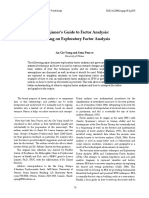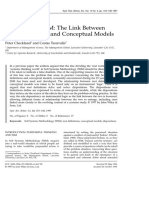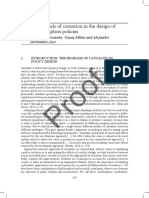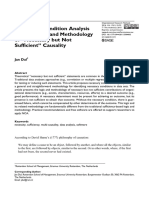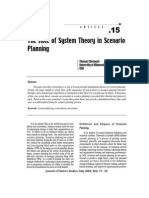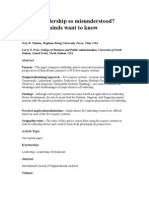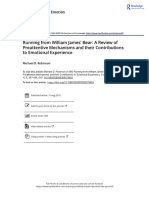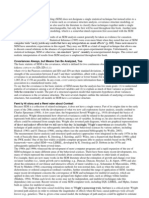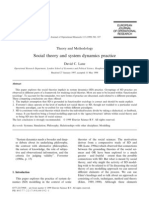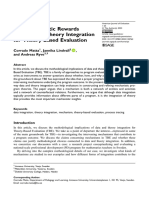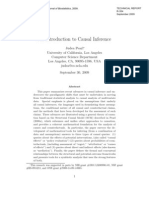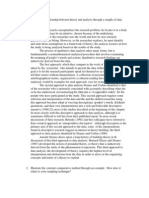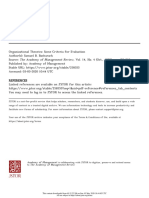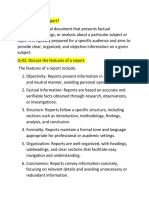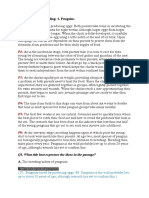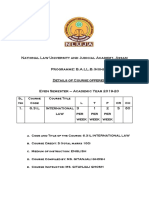Book Reviews: Revisiting Realistic Evaluation
Book Reviews: Revisiting Realistic Evaluation
Uploaded by
Muaz JalilCopyright:
Available Formats
Book Reviews: Revisiting Realistic Evaluation
Book Reviews: Revisiting Realistic Evaluation
Uploaded by
Muaz JalilOriginal Title
Copyright
Available Formats
Share this document
Did you find this document useful?
Is this content inappropriate?
Copyright:
Available Formats
Book Reviews: Revisiting Realistic Evaluation
Book Reviews: Revisiting Realistic Evaluation
Uploaded by
Muaz JalilCopyright:
Available Formats
http://evaluation.wmich.
edu/jmde/ Book Reviews
Book Reviews
Revisiting Realistic Evaluation
Chris L. S. Coryn
Albeit some might argue that this review is a little late in coming, it is worth
revisiting Pawson and Tilley’s 1997 book, Realistic Evaluation (reprinted in 1998,
2000, 2001, and 2002) as the debate about causation and evidence-based research
and evaluation continues to be a topic of debate and concern in the evaluation and
research communities (see A Call to Action: The First International Congress of
Qualitative Inquiry and The Claremont Debate, in this issue of JMDE). Realistic
Evaluation is rooted in the tradition of scientific realism, which is said to be one of
the “dominant axes in modern European thinking” (p. 55). In the most general of
terms scientific realism concerns “the nature and operation of causal forces” (p.
55). The essential ingredients for assessing these causal forces are C-M-O
configurations—where C represents context, M represents mechanisms, and O
represents outcomes. Context refers to the “spatial and institutional locations of
social situations, together, crucially, with the norms, values, and interrelationships
found in them” (p. 216). Mechanisms are the “choices and capacities which lead to
regular patterns of social behavior” and the causal mechanisms which generate
these patterns of behavior are “deemed ‘social problems’ and which are the
rationale for a program” (p. 216). Outcomes “provide the key evidence for the
Journal of MultiDisciplinary Evaluation (JMDE:3) 143
ISSN 1556-8180
http://evaluation.wmich.edu/jmde/ Book Reviews
realist evaluator in any recommendation to mount, monitor, modify, or mothball a
program” (p. 217). From the C-M-O configuration, the authors argue that the way
in which causation in the “social world should be constructed” and that the “basic
realist formula” is “mechanism + context = outcome” (p. xv).
Chapter 1, A History of Evaluation in 28 ½ Pages, presents Pawson and Tilley’s
version of the history of evaluation. The authors begin this history with the
experimental evaluations of the 1960s of the “great social programs of the ‘great
society’ [the U.S.]” (p. 2) brought about by the work of Stanley and Campbell,
among others. In short, the experimental paradigm is described as a failure for a
variety of reasons, including the lack of external validity (i.e., generalizability)
brought about by experiments’ inability to reproduce results in the ‘real world.’
Somewhat out of place, but next in the short history of evaluation are the
utilization-focused approaches. These approaches are criticized on the grounds that
“he who pays the researcher calls the methodological tune” (p. 14). Finally, the
emergence of constructivism in the 1970s is reviewed and also described as a
disappointment because of the “inability to grasp those structural and institutional
features of society which are in some respects independent of individuals’
reasoning and desires” (p. 23). All in all, the authors paint a bleak picture of
evaluation’s past and contend that if the future is to be brighter then evaluators had
better take theory seriously, although the authors also find serious flaws in the
various theory-driven approaches of Chen, Weiss, and others. These faults are
described as the lack of attention given to context and the emphasis on
experimental methods, for example. This 28 ½ page history of evaluation is
intended to set the stage and substantiate the authors approach to and purposes for
evaluation: determining not only ‘if’ a program works, but also ‘how’ and for
‘whom.’
Journal of MultiDisciplinary Evaluation (JMDE:3) 144
ISSN 1556-8180
http://evaluation.wmich.edu/jmde/ Book Reviews
Chapter 2, Weaknesses in Experimental Evaluation, presents Pawson and Tilley’s
expose on the inherent problems with the experimental tradition; namely, the
experimentalists’ “epistemological assumptions about causation and their lack of
fit with the nature of social programs” (p. 30). Essentially, the authors argue that
more often than not that change cannot be captured in OXO terminology. All in all,
it is asserted that “by its very logic, experimental evaluation either ignores these
underlying process [causal mechanisms], or treats them incorrectly as inputs,
outputs or confounding variables, or deals with them in a post hoc and thus
arbitrary fashion” (p. 54).
In Chapter 3, In With the New: Scientific Realism, the authors present the
principles and practice of scientific realism. As previously mentioned, the realist
view (generative) of causation can be described thusly (as illustrated by the
explosion of gunpowder):
Our basic concern is still, of course, the outcome (the spark causing the
explosion). But what does the explanatory work is first of all the mechanism (the
chemical composition of the substance which allows the reaction), and secondly
the context (the physical conditions which allow the mechanism to come into
operation). This proposition—causal outcomes follow mechanisms acting in
contexts—is the axiomatic base upon which all realist explanations build.
(Pawson & Tilley, 1997, p. 58)
Journal of MultiDisciplinary Evaluation (JMDE:3) 145
ISSN 1556-8180
http://evaluation.wmich.edu/jmde/ Book Reviews
context
mechanism
An action is causal only if…
outcome
…its outcome is triggered by a mechanism acting in context
Source: Pawson, R. and Tilley, N. (1997). Realistic evaluation. Thousand Oaks, CA: Sage.
Figure 1. Generative Causation
Chapter 4, How to Design a Realistic Evaluation, presents the realist evaluation
cycle (see Figure 2) and three case studies which apply realist evaluation principles
to varying degrees.
Mechanisms (M)
Contexts (C)
Outcomes (O)
Theory
What works for What might
whom in what work for whom
circumstances in what
circumstances
Program specification Hypotheses
Observations
Multi-method data
collection and analysis
on M, C, O
Source: Pawson, R. and Tilley, N. (1997). Realistic evaluation. Thousand Oaks, CA: Sage.
Figure 2. The Realist Evaluation Cycle
Journal of MultiDisciplinary Evaluation (JMDE:3) 146
ISSN 1556-8180
http://evaluation.wmich.edu/jmde/ Book Reviews
The first case study presented is an evaluation of property marking and described
by the authors as testing theory, the second is an evaluation of a housing project
and described as theory formation and development, and the third is an evaluation
of a prison-delivered higher education program also described as theory formation
and development. These case studies are described in some detail and are intended
to represent exemplars of realistic evaluation.
I have opted to exclude a review of the remaining chapters (5-9) as these merely
focus on collecting realist data and the methodological procedures involved in
conducting evaluation as prescribed by Pawson and Tilley.
Despite the book’s title, the true underlying premise of Pawson and Tilley’s
Realistic Evaluation is not merely a proposition of how to conduct evaluation, but
rather a treatise on the nature of causation and science. While the author’s notion
of causation (scientific realism) is compelling, I am not entirely convinced that it is
the “final solution” to the causation debate. Neither is it a dramatic improvement
over either successionist or other traditions. In their haste to prescribe generative
explanations they fail to recognize or acknowledge that numerous experimentalists
(and non-experimentalists) give considerable attention to context in their accounts
of causation (e.g., moderators, mediators, interaction effects), often to a greater
degree than the examples provided throughout the book suggest. Moreover, these
causal accounts (i.e., realist accounts) seem little more than explanations of
program effectiveness for different groups or consumers, which can be
accomplished without the use of realist principles.
Prior reviews (Patton, 1999; Rogers, 1999) of Realistic Evaluation have been
mixed. For example, Rogers (1999) stated that “this is one of those rare books that
has the potential to permanently change one’s perspective on program evaluation”
Journal of MultiDisciplinary Evaluation (JMDE:3) 147
ISSN 1556-8180
http://evaluation.wmich.edu/jmde/ Book Reviews
(p. 381). Patton (1999), on the other hand, was not entirely convinced of the
credibility of Pawson and Tilley’s contribution and responded to their criticisms of
utilization-focused evaluation (p. 14) thusly:
I rarely respond to attacks on or distortions of my views, especially when they’re
based on the twenty-year-old first edition of the book (Patton, 1978) and don’t
take into account subsequent revisions and elaborations (Patton, 1986, 1997) that
I hope have corrected at least some earlier weaknesses, and have benefited from
well-deserved and well-meaning critiques. I have learned that responding to a
distortion risks reinforcing the very thing I want to correct by calling attention to
it. However, the distortions in the opening chapter of Pawson and Tilley, in which
they sarcastically and disparagingly review (and bemoan) the history of
evaluation, are anything but innocent or trivial. The irony is that, in the
introduction, the authors claim the mantle of “detachment,” “objectivity,” and
“scientific evaluation” (p. xiii). Their mocking review of evaluation’s history has
one primary purpose: positioning themselves as saviors of the profession by
redirecting us to be scientists first and foremost.
(Patton, 1999, p. 387)
While Realistic Evaluation has spurred serious interest and debate, and even
spawned an issue of New Directions for Evaluation (Henry, Julnes, & Mark,
1998), the approach has not quite received the attention in North America that it
has in the United Kingdom and Europe. A search of the American and Canadian
evaluation journals did not turn-up any publications related to the approach (with
the exception of Patton and Roger’s reviews of the book). While a search of the
major European evaluation journal (Evaluation: The International Journal of
Theory, Research, and Practice) returned 56 articles which focused on, or
emphasized, the realistic evaluation approach.
Journal of MultiDisciplinary Evaluation (JMDE:3) 148
ISSN 1556-8180
http://evaluation.wmich.edu/jmde/ Book Reviews
References
Henry, G. T., Julnes, G. & Mark, M. M. (Eds.) (1998). Realist evaluation: An
emerging theory in support of practice. New Directions for Evaluation, 78.
Patton, M. Q. (1999). Realistic evaluation [review of the book Realistic
evaluation]. American Journal of Evaluation, 20(2), 385-388.
Pawson, R. and Tilley, N. (1997). Realistic evaluation. Thousand Oaks, CA: Sage.
Rogers, P. J. (1999). Realistic evaluation [review of the book Realistic evaluation].
American Journal of Evaluation, 20(2), 381-383.
Journal of MultiDisciplinary Evaluation (JMDE:3) 149
ISSN 1556-8180
You might also like
- Schoonhoven, C.B. 1981. Problems With Contingency Theory Testing Assumptions HiddenDocument30 pagesSchoonhoven, C.B. 1981. Problems With Contingency Theory Testing Assumptions HiddenMuhammad UsmanNo ratings yet
- The Role of Factor Analysis in The DevelDocument44 pagesThe Role of Factor Analysis in The DevelSNo ratings yet
- A Meditation On Mediation: Evidence That Structural Equations Models Perform Better Than RegressionsDocument15 pagesA Meditation On Mediation: Evidence That Structural Equations Models Perform Better Than RegressionsGabriel Horn IwayaNo ratings yet
- Frey TestTheoryClassicalTestTheoryDocument3 pagesFrey TestTheoryClassicalTestTheoryworood.khalifih90No ratings yet
- Ferguson 1993Document11 pagesFerguson 1993Puspa Triani AdindaNo ratings yet
- A Beginner's Guide To Factor Analysis: Focusing On Exploratory Factor AnalysisDocument16 pagesA Beginner's Guide To Factor Analysis: Focusing On Exploratory Factor AnalysisMumTagguRmgNo ratings yet
- Roles For Theory in Evaluation PracticeDocument32 pagesRoles For Theory in Evaluation PracticeGerda WarnholtzNo ratings yet
- Definition of TheoryDocument8 pagesDefinition of TheoryZyrel Joy Santos MirandaNo ratings yet
- Munck ToolsforQualitativeResearch 2004Document10 pagesMunck ToolsforQualitativeResearch 2004sheaNo ratings yet
- Arghode 2012 GEJDocument10 pagesArghode 2012 GEJKatherine Uran RamirezNo ratings yet
- A Practical Iterative Framework For Qualitative Data AnalysisDocument9 pagesA Practical Iterative Framework For Qualitative Data AnalysisHamidur Rahman SabbirNo ratings yet
- (Sici) 1099-1743 (199705 06) 14 3 153 Aid-Sres134 3.0.co 2-HDocument16 pages(Sici) 1099-1743 (199705 06) 14 3 153 Aid-Sres134 3.0.co 2-HpiturdabNo ratings yet
- Falleti and Lynch 2009 Context-Causal-MechanismDocument12 pagesFalleti and Lynch 2009 Context-Causal-Mechanismmarting91No ratings yet
- A Taxonomy of Organizational Justice Theories PDFDocument15 pagesA Taxonomy of Organizational Justice Theories PDFAnnah TedeNo ratings yet
- 10.4 Langley AMR1999 - Strategies For Theorizing From Process DataDocument21 pages10.4 Langley AMR1999 - Strategies For Theorizing From Process DatacarlosadmgoNo ratings yet
- Ch. 2 Talk About Theory-Building Theory HANDOUTDocument3 pagesCh. 2 Talk About Theory-Building Theory HANDOUTElsiechNo ratings yet
- Molecular Pathways and The Contextual Explanation of Molecular FunctionsDocument19 pagesMolecular Pathways and The Contextual Explanation of Molecular FunctionsruyhenriquezNo ratings yet
- Four Models of Anti-Corruption PoliciesDocument19 pagesFour Models of Anti-Corruption PoliciesDonatella Bourne CNo ratings yet
- The Handbook of Communication ScienceDocument16 pagesThe Handbook of Communication ScienceSonsolesNo ratings yet
- Necessary Condition Analysis Necessary But Not Sufficient CausalityDocument43 pagesNecessary Condition Analysis Necessary But Not Sufficient CausalityJulieth BltNo ratings yet
- Models That Includes Cows The Significance of Operational ThinkingDocument20 pagesModels That Includes Cows The Significance of Operational ThinkingHarold lamphreyNo ratings yet
- Flake Pek Hehman SPPSDocument9 pagesFlake Pek Hehman SPPSnilaNo ratings yet
- Model Conceptualization A Critical ReviewDocument12 pagesModel Conceptualization A Critical ReviewBilal TaşkınNo ratings yet
- ScenariosDocument16 pagesScenariosAnuta CostinelNo ratings yet
- A Review of Scale Development Practices in The Study of OrganizationsDocument23 pagesA Review of Scale Development Practices in The Study of OrganizationsLuana FerreiraNo ratings yet
- Frey TestTheoryClassicalTestTheoryDocument2 pagesFrey TestTheoryClassicalTestTheorykambangamercy22No ratings yet
- Analytic Induction As A Qualitative Research Method of AnalysisDocument4 pagesAnalytic Induction As A Qualitative Research Method of Analysisl540lNo ratings yet
- Why Is Leadership So Misunderstood? Inquiring Minds Want To KnowDocument14 pagesWhy Is Leadership So Misunderstood? Inquiring Minds Want To Knowshahida husna100% (2)
- What 'S in A Mechanism? Development of A Key Concept in Realist EvaluationDocument7 pagesWhat 'S in A Mechanism? Development of A Key Concept in Realist EvaluationsuhailNo ratings yet
- Running From William James Bear A Review of Preattentive Mechanisms and Their Contributions To Emotional ExperienceDocument31 pagesRunning From William James Bear A Review of Preattentive Mechanisms and Their Contributions To Emotional ExperienceDaniel Jann CotiaNo ratings yet
- Quantitative Theory PPT ClassDocument10 pagesQuantitative Theory PPT ClassLogistics teamNo ratings yet
- Andrews 1996 PDFDocument20 pagesAndrews 1996 PDFMargareth MarconNo ratings yet
- Characteristics of SEM: Cov R SD SDDocument9 pagesCharacteristics of SEM: Cov R SD SDHans JonniNo ratings yet
- TimothyDocument21 pagesTimothyh23158No ratings yet
- Social Theory SD LaneDocument27 pagesSocial Theory SD LaneLuis TamashiroNo ratings yet
- The IS Effectiveness Matrix The Importance of StakDocument13 pagesThe IS Effectiveness Matrix The Importance of StakLaurence GuerreroNo ratings yet
- Matta Et Al 2023 The Mechanistic Rewards of Data and Theory Integration For Theory Based EvaluationDocument23 pagesMatta Et Al 2023 The Mechanistic Rewards of Data and Theory Integration For Theory Based EvaluationkevinNo ratings yet
- American Economic Association The American Economic ReviewDocument9 pagesAmerican Economic Association The American Economic ReviewStefanAndreiNo ratings yet
- Debunking Myths and Urban Legends About Meta-AnalysisDocument26 pagesDebunking Myths and Urban Legends About Meta-AnalysisPaula González LeónNo ratings yet
- Bacharach, 1989Document21 pagesBacharach, 1989Bey AlivandNo ratings yet
- Microeconomic Systems As An Experimental ScienceDocument34 pagesMicroeconomic Systems As An Experimental ScienceAlim Somethin WateverNo ratings yet
- Data Terjemahan IkhsanDocument5 pagesData Terjemahan Ikhsanma nahdlotussibyanNo ratings yet
- Pearl 2021 - The Causal Foundations of Structural Equattion ModelingDocument40 pagesPearl 2021 - The Causal Foundations of Structural Equattion ModelingPabloNeudörferNo ratings yet
- Symposium 4 p95Document14 pagesSymposium 4 p95Thảo ThảoNo ratings yet
- Paws On 2002Document19 pagesPaws On 2002siti prizkanisaNo ratings yet
- 151-Published-Paweł CABAŁA-2010-Using The AHP in Evaluating Decision AlternativesDocument19 pages151-Published-Paweł CABAŁA-2010-Using The AHP in Evaluating Decision AlternativesRahmat AdiNo ratings yet
- System Dynamics As Model-Based Theory BuildingDocument19 pagesSystem Dynamics As Model-Based Theory BuildingTheGimhan123No ratings yet
- What Is Research Anyway?Document5 pagesWhat Is Research Anyway?Muhammad Jahanzeb AamirNo ratings yet
- Recording, Managing, and Analyzing DataDocument4 pagesRecording, Managing, and Analyzing DataNorhayatii NorhayatiNo ratings yet
- Rhee Case StudyDocument6 pagesRhee Case StudySoumiaNo ratings yet
- Theory CntigencyDocument28 pagesTheory CntigencyMahathir FansuriNo ratings yet
- An Introduction To Causal InferenceDocument67 pagesAn Introduction To Causal InferenceStefan SegersNo ratings yet
- Discuss The Relationship Between Theory and Anlysis Through A Sample of Data From Your StudyDocument5 pagesDiscuss The Relationship Between Theory and Anlysis Through A Sample of Data From Your StudyInga Budadoy Naudadong100% (1)
- Truth FoSDocument18 pagesTruth FoSkarpiuk.janekNo ratings yet
- Academy of Management The Academy of Management ReviewDocument21 pagesAcademy of Management The Academy of Management ReviewZafar IqbalNo ratings yet
- Adaptive Behavior and Economic TheoryDocument27 pagesAdaptive Behavior and Economic TheoryFarnoudNo ratings yet
- The Ongoing Process of Building A Theory of DisruptionDocument18 pagesThe Ongoing Process of Building A Theory of DisruptionVinicius MinatogawaNo ratings yet
- Mainstream Accounting and Its Paradigm A CriticalDocument15 pagesMainstream Accounting and Its Paradigm A CriticalMagnum DotoNo ratings yet
- How To Do A Rigorous, Evidence-Focused Literature Review in International DevelopmentDocument27 pagesHow To Do A Rigorous, Evidence-Focused Literature Review in International DevelopmentMuaz JalilNo ratings yet
- Systematic Review JRSMDocument7 pagesSystematic Review JRSMMuaz JalilNo ratings yet
- Theories of Change and Realistic Evaluation: Peas in A Pod or Apples and Oranges?Document17 pagesTheories of Change and Realistic Evaluation: Peas in A Pod or Apples and Oranges?Muaz JalilNo ratings yet
- Muaz JalilDocument4 pagesMuaz JalilMuaz JalilNo ratings yet
- Basketball: History & Nature of The GameDocument2 pagesBasketball: History & Nature of The GameJosh Schultz100% (1)
- Weekend Schedule - IMS KoramangalaDocument7 pagesWeekend Schedule - IMS Koramangalaaviansoul28No ratings yet
- Year 11-Addmaths-Paper 1-Trial2Document13 pagesYear 11-Addmaths-Paper 1-Trial2Ivan TanNo ratings yet
- Genre Text Type: Mind MapDocument7 pagesGenre Text Type: Mind MapRisaaNo ratings yet
- KCET 2023 Agri Cutoff Gen Round 1Document4 pagesKCET 2023 Agri Cutoff Gen Round 1yashwanthNo ratings yet
- Raghunath Luitel - Reason For Study EnglishDocument1 pageRaghunath Luitel - Reason For Study EnglishSuresh Sing BasnyatNo ratings yet
- English 4 - Session 7A SDDocument78 pagesEnglish 4 - Session 7A SDJoel R. Lacuesta100% (2)
- Topic 3 Report WritingDocument6 pagesTopic 3 Report WritingAfifa MahmoodNo ratings yet
- Engineering Drawing: Course OverviewDocument2 pagesEngineering Drawing: Course OverviewmuthuNo ratings yet
- UNIT 3 - Voice Your Mind in A Small Country Called A ClassDocument10 pagesUNIT 3 - Voice Your Mind in A Small Country Called A Classskripsiniken07No ratings yet
- IBM Thinkpad R40 SeriesDocument9 pagesIBM Thinkpad R40 SeriesAlexandru Si AtatNo ratings yet
- Nursing Care Plan Surgical PDFDocument2 pagesNursing Care Plan Surgical PDFDanielle Audrey100% (2)
- Ched Draft of Policies and Guidelines Re. - Monitoring and Evaluation of Maritime Programs 07-15-2011 For MANCOMDocument11 pagesChed Draft of Policies and Guidelines Re. - Monitoring and Evaluation of Maritime Programs 07-15-2011 For MANCOMLeyCodes LeyCodesNo ratings yet
- Press: Council Conclusions On A Benchmark For Learning MobilityDocument8 pagesPress: Council Conclusions On A Benchmark For Learning MobilityLenna ZabaNo ratings yet
- Resolution - SGC-Implementation TEAM BUILDING LINGAP CLUBDocument2 pagesResolution - SGC-Implementation TEAM BUILDING LINGAP CLUBMARK ANDREW CATAP100% (1)
- CV Jean-Gerome CarreyDocument1 pageCV Jean-Gerome Carreyapi-3762060No ratings yet
- Emotional Intelligence Do's and Tips For Each Subscale 2022Document17 pagesEmotional Intelligence Do's and Tips For Each Subscale 2022begum1likNo ratings yet
- Basic ERP Implementation System: SynopsisDocument5 pagesBasic ERP Implementation System: SynopsismikeNo ratings yet
- Multiple Choice Reading For NN Anh 21BDocument5 pagesMultiple Choice Reading For NN Anh 21BNguyễn Thu ThảoNo ratings yet
- Finley Arts-Based InquiryDocument14 pagesFinley Arts-Based InquirymacarcuzNo ratings yet
- 12 Re Letter of Atty. Estelito P. MendozaDocument2 pages12 Re Letter of Atty. Estelito P. MendozaJudy Ann ShengNo ratings yet
- From Mythos To Logos Jean Pierre VernantDocument30 pagesFrom Mythos To Logos Jean Pierre Vernantkaren santosNo ratings yet
- How To Contact Thesis SupervisorDocument5 pagesHow To Contact Thesis Supervisortishanoelfrisco100% (2)
- Class 11 Maths Sample Paper Set 13Document9 pagesClass 11 Maths Sample Paper Set 13Artham ResourcesNo ratings yet
- Journal Smart School 1 PDFDocument5 pagesJournal Smart School 1 PDFsuesmktbbNo ratings yet
- MG414 CW1 Assignment BriefDocument7 pagesMG414 CW1 Assignment Brieffortunicolae434No ratings yet
- The Past Continuous TenseDocument4 pagesThe Past Continuous TenseYeerina DebnathNo ratings yet
- CAIPE Interprofessional Education Guidelines 2016 1 PDFDocument26 pagesCAIPE Interprofessional Education Guidelines 2016 1 PDFagstriansNo ratings yet
- 6.3 Il 2019 Jan-June SyllabusDocument18 pages6.3 Il 2019 Jan-June SyllabusBrijbhan Singh RajawatNo ratings yet
- August 10 2014 BulletinDocument2 pagesAugust 10 2014 Bulletinapi-64295783No ratings yet





